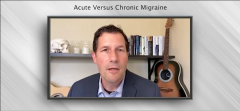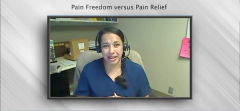
5-HT1F Agonist Toxicity Profile and Role in Paradigm
Episodes in this series

A key opinion leader discusses the adverse event profile of the 5-HT1F agonist lasmiditan and considers its role in the acute migraine treatment paradigm.
Wade M. Cooper, DO: When we talk about lasmiditan, there are a lot of things to think about from an adverse effect concept. The first thing to understand with the adverse effects in lasmiditan, is to appreciate how it’s working. We first know that lasmiditan can reduce CGRP [calcitonin gene-related peptide] effects in the periphery, but we don’t really think that’s its main mechanism of action.
We think the main mechanism of action is reducing the serotonergic 5-HT1F receptor in the periphery, but maybe even more important, lasmiditan can penetrate into the central nervous system, where there are 5-HT1F receptors located. This includes very important areas related to migraine, including the hypothalamus and the thalamus, the locus coeruleus, periaqueductal gray, and many other spaces that are involved in the migraine circuitry.
What’s phenomenal about lasmiditan is it crosses into the central nervous system and has central effects. I also mention that to my patients, because it helps us understand its adverse effect profile. It’s different than peripherally acting gepants, which have minimal adverse effects outside of, perhaps, nausea, and different than the triptans, which typically affect the peripheral nervous system, and give people the serotonergic flushing we see peripherally: increased heart rate, squeezing of the soft muscles in their throat and chest, and paresthesias of the scalp.
We also know that lasmiditan avoids most of that and works on its central effects. Because of that, lasmiditan has a chance to cause dizziness, which is a big issue, rare chance of vertigo, and a lot of people feel weakness, as if they just don’t have energy, not that they can’t move their arms or legs, but they generally feel low energy.
In a recent study, it was found that about 1 in 10 patients who received lasmiditan had 1 of these symptoms, and unfortunately, this can affect people in different degrees. Sometimes severe, about 1 in 100 people have a severe episode of dizziness when they use lasmiditan, and unfortunately, patients can’t always tell when they feel this way. Because the medication is centrally acting, the FDA decided to put a no-driving restriction on this medication, so people who are prescribed lasmiditan, when they use the medicine, can’t drive for 8 hours.
This is not negotiable, so you can’t tell your patients, try it once, if you feel great, then you can go back to driving or operating heavy machinery. This is a hard stop. Eight hours, no driving, and we really hold tight to that in our practice. Remember, patients may not notice if they feel dizzy or some of the mild vertigo, and you don’t want them behind the wheel of a car. However, I also like to point out, because of these adverse effects, you’ve also got incredible efficacy, and that’s one of the most exciting parts about lasmiditan.
In my opinion, it has more efficacy than a lot of other acute therapies out there. Their published studies show efficacy that is similar or better to almost every triptan study that I’ve seen, including benefits for treating headache 4 hours in. Remember, triptans, many times are less effective the longer you wait. We think that’s because they work mostly peripherally, but lasmiditan, because it works centrally, gives you an even bigger window to take your medication, and offers pretty impressive results with efficacy.
When I think about the role for lasmiditan, in a headache practice, or in a general neurology office, it’s actually quite large, because a lot of times patients won’t tell you they’re not getting the effect they deserve from their acute therapy. So ask the questions, “How effective is your therapy for you? How reliable is your therapy for you? How many times do you get pain freedom of 2 hours?” They’re important questions, because lasmiditan offers the ability to get people pain free at 2 hours, and sustain pain freedom at 48 hours, better than almost anything I am familiar with.
In our practice, we use it for people who have refractory migraine, people who don’t respond well to the typical agents, such as NSAID [nonsteroidal anti-inflammatory drug]-class medicines or over-the-counter medicines, people who haven’t responded to a triptan before, those are the people who I think are excellent candidates for lasmiditan. In my opinion, people who have a large central nervous system component to their migraine, that includes migraine with the prodrome, with autonomic features like…nasal stuffiness, that includes people with migraine who feel fatigued after the migraine in their postdrome, or feel a confusion element, or have episodes where their aura is profound. Those are the people who tend to respond fantastically with lasmiditan in our practice.
We’ve adopted this since it was FDA-approved, and some of my patients have some very creative things to say about it. One of my patients, I’ll have to paraphrase this, says, “It’s better than any of the rest of the blank that you’ve put me on before.” And they also say, “This medication is expletive phenomenal.” What that patient really means is that they’ve been struggling with migraine for a long time, and they’ve looked for ways to stop acute headache when it occurs so that it’s not like a wrecking ball through their quality of life.
Lasmiditan is one of the medicines for this person, the only 1 so far, that has been able to stop their migraine in its tracks and return to them a day that would have been otherwise stolen by the thief of migraine.
Newsletter
Keep your finger on the pulse of neurology—subscribe to NeurologyLive for expert interviews, new data, and breakthrough treatment updates.









































